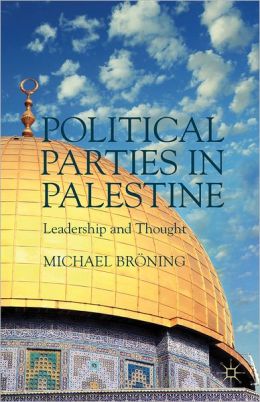Political Parties in Palestine is an up-to-date elucidation of the Palestinian political landscape, aiming to offer vital background information on movements such as Hamas and Fatah, as well as smaller political factions that have defined the Israeli-Palestinian conflict for decades but, due to lack of available information, have not been subject to academic scrutiny. Michael Bröning’s book is an unquestionably important contribution to the study of Palestinian politics, and a must-read for anyone who hopes to better understand both intra-Palestinian political dynamics, and the Israeli-Palestinian conflict.
Bröning offers several explanations for this “blind spot” in the exiting literature, including the fact that many of these political movements are now, or have been historically, viewed as terrorist groups by Israel and most western governments. He also suggests that the organisations’ identification as “movements” and “liberation fronts” rather than “parties” is an indicator of their self-perceptions and a reflection of the inadequacies of the political system in which they operate. In other words, these labels illustrate and explain the organisations’ incomplete transition into clearly defined political parties and obfuscate their policy positions. Bröning also acknowledges the disadvantages of excluding other political actors from his study, such as Islamic Jihad, which rejected the electoral process, or the Palestinian Democratic Union, which failed to win a seat in the 2006 PLC election. However, he asserts that this study nonetheless illuminates the political influence of lesser-known factions and offers new insights into the ideological ambiguities, changes, and continuities of the Palestinian political discourse.
The subsequent chapters focus on individual PLC factions: Hamas, Fatah, the Popular Front for the Liberation of Palestine (PLFP), The Palestinian National Initiative (PNI), the Palestinian People’s Party (PPP), and the Democratic Front for the Liberation of Palestine (DLFP). Each chapter contains a historical overview, biographies of leading personalities, interviews with influential party members and excerpts from key programmatic documents. Particularly helpful in these chapters are the organisational charts of each movement’s complex decision-making structures.
Bröning identifies three phases of Palestinian nationalism: pan-Arabism, the primacy of Fatah, and the “rise of Hamas.” This present phase constitutes the period since Hamas’s 2006 PLC election victory and the ensuing political polarization between the secular Fatah and religious Hamas. The Hamas chapter discusses not only the movement’s impact on Palestinian political institutions, but the influence of its electoral victory on Hamas’s own internal discourse. This chapter suggests an internal split between the movement’s military and political wings as well as within the organisation’s geographically fragmented leadership, a common trope in recent case studies about Hamas. Excerpts from programmatic documents allow readers to glimpse the evolution of the movement’s official policy positions on such key issues as prospects for peace with Israel, economic development, and the movement’s vision of state-society relations. Bröning selected excerpts from Hamas’s oft-criticized 1988 charter, the election program of its 2006 Change and Reform electoral list, the program of the 2007 National Unity Government, and the 2011-2012 Gaza Ministry of Planning development plan, which the he translated from the original Arabic. Arguably, however, the most interesting and insightful component of this chapter is the section of interviews with party decision-makers. These interviews illustrate the diversity of opinion within the organisation on such topics as Palestinian national unity, the role of women in the party, and the movement’s political identity.
The PNI, the youngest faction covered in this text, was formed in 2002 by former PPP member Mustafa Barghouthi, Haider Abdel-Shafi, Ibrahim Dakkak and prominent Palestinian academic Edward Said, at the height of the second intifada (popular uprising). This chapter highlights the party’s origins in the leadership of the communist PPP and acknowledges its failure to either supplant or unite the Palestinian left, which, is severely fragmented. The author identifies several noteworthy attributes of this understudied, albeit ideologically influential movement. These characteristics include the personal charisma of Barghouthi, the party’s pragmatic economic platform, and its emphasis on non-violent resistance and civil disobedience as a means of achieving political objectives. Barghouthi, who is one of two PNI leaders interviewed in this chapter, emphasises the movement’s unique position as the first party to implement such non-violent methods of resistance. He notes, “I think our non-violent approach is succeeding and has become the main form of struggle in Palestine today” (p.133). While other factions such as Hamas and the DFLP assert the legitimacy violent resistance against the Israeli occupation, interviews in these chapters indicated that they also recognise the potential efficacy of peaceful resistance.
Bröning’s study illustrates the ideological and programmatic consistencies (and inconsistencies) of Palestinian political factions and provides useful insight into several understudied groups. However, structurally, this book would have benefited from a brief summary chapter or individual chapter conclusions, as the text’s abrupt ending nearly takes away from the otherwise excellent historical analyses and rich primary source material. Additionally, since Bröning does not analyse any of the political documents in depth (which is not the purpose of this study), an appendix containing the full text of the previously un-translated documents would also have been useful for readers who wish to examine them independently.
This study acknowledges the crippling limitations that the Israeli occupation places on Palestinian politics, yet robs the Palestinian actors of neither agency nor accountability. The political events that followed its publication – most notably, Palestinian Authority Prime Minister Salam Fayyad’s April 2013 resignation – only highlight its timeliness, rather than render it dated. Bröning’s book is an unquestionably important contribution to the study of Palestinian politics, and a must-read for anyone who hopes to better understand both intra-Palestinian political dynamics, and the Israeli-Palestinian conflict.

No comments:
Post a Comment